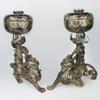Reading The Du Hua Of Chinese Paintings At Gianguan Auctions
- NEW YORK, New York
- /
- August 17, 2018
The Chinese paintings coming to the podium at Gianguan Auctions on September 8th hold strong interest for collectors familiar with the form and may well serve as an introduction to the du hua of Chinese paintings for others interested in learning how “to read a painting”.
Since the dawn of the dynasties, paintings with brush and ink have been the domain of poets and multi-talented scholars, visionary emperors, and monks. In the twentieth century globe-trotting experimentalists commanded the respect of Picasso, well-known patrons, and the press. Today’s collectors look for idealism, technique, and provenance, as expressed by the Emperors’ seals, collectors seals and artist's signature seals that dot the edges of most paintings.
By the start of the Tang Dynasty (618-907 AD) calligraphy was the highest form of visual art. The measure of calligraphy–in addition to the emotion expressed through the counterbalance of order and dynamism–was found in the words themselves. “Calligraphy,” an eight-foot panel by Liu Gongquan (one of four masters of regular script) is a tour de force of the period. Thirteen Emperors’ seals and fourteen Collectors’ seals attest to its aesthetic impact. Liu Gongquan’s “Calligraphy” is Lot 98, valued at more than $2M.
Another offering is the sharp, semi cursive script of Zhang Ruitu, a Ming master and poet. Zhang Ruitu’s “Calligraphy” is Lot 105, signed by the artist, 25” inches in length, with two artists seals, valued at upwards of $20,000.
Please note the Gianguan Catalog does justice to very large scroll paintings by portraying them in panels that simulate the span one would see if opening a hand scroll as intended, right hand reaching from the shoulder outward.
Paintings took on legitimacy as an art form around the time of the Song Dynasty (960-1279) and paintings from that period as well as the later Yuan and Ming Dynasties continue to prove strong investments.
Leading paintings of the natural world is “Bird on a Twig,” by Zhao Ji, the personal name of the eighth emperor of the Song. Unlike western nature paintings, Chinese works are not literal interpretations but rather a depiction of the artist’s private visual. Characterized by fine brush work that allows a crested bird to sit lightly on a branch of yellow flowers, this is an album page, a squarish format, mounted and framed. It has one Emperor’s seal and three Collectors’ seals. Zhao Ji’s “Bird on a Twig” is Lot 106, likely to soar above its $850,000 opening estimate.
A more accessible Northern Song album leaf is “Chirping Birds” by Xu Chongju. Here the ephemeral lightness of singing birds and leaves is captured in tones of gray. With three Emperors’ seals and eight Collectors’ seals, Xu Chongju’s “Chirping Birds” is Lot 157. The opening bid is $20,000.
By the late Tang Dynasty, landscapes came to prominence reflecting the universal longing to escape one’s confines and explore nature. Yuan Dynasty (13th-mid-14th centuries) painter Huang Gongwang’s “Visit” is among these. With China’s mountainous terrain as metaphor for the reaching of humans to heaven, houses of mortals nestle in its crooks and pockets. With seven Emperors’ seals and three Collector’s seals the ink with muted color on paper, Lot 131 is poised to bring upwards of $600,000.
A more energetic landscape is twentieth century artist Wu Guanzhong’s “Suhang Landscape.” Often called the founder of Chinese Modern Art, he delivers the terrain in bold abstractions of black ink over a white ground populated with splashes of color. The twelve-foot work is Lot 193, expected to go off at $80,000 or more.
Horses, symbols of power and virtue, have been popular subjects for hundreds of years. Xu Beihong’s 1940 “Horse Standing” is the modernist interpretation. Shown in three-quarter profile, a black horse is at ease on a green and tan field. It is Lot 107, expected to go off at more than $50,000. Several more Xu Beihong paintings illustrate his magnificent way with horses and carry appropriate estimates.
Yangyong Ding, who witnessed and then experimented with 20th century movements in modern art, is represented by three outstanding works. “Frogs” (Lot 77), “Cat and Butterfly” (Lot 78) and “Chrysanthemum and Insects” (Lot 79). Each masterfully conveys power with few brush strokes. These excellent bargains start at $3,000 each.
For details, in Chinese and English, on the paintings in Gianguan’s September 8th sale, please visit www.gianguanauctions.com. Live previews run Wednesday, August 29 - Friday, September 7 (10 a.m.-7 p.m. EDT) at Gianguan Auctions gallery in New York City. The auction will be conducted live on Saturday, September 8, beginning at 6 PM EDT. Bidding is live or online at invaluable.com, liveauctioners.com and epailive.com.
For inquiries and condition reports, please contact the Gallery Director Mary Ann at 212-867-7288 or email info@gianguanauctions.com.

270x400_c.jpg)
















100x100_c.jpg)